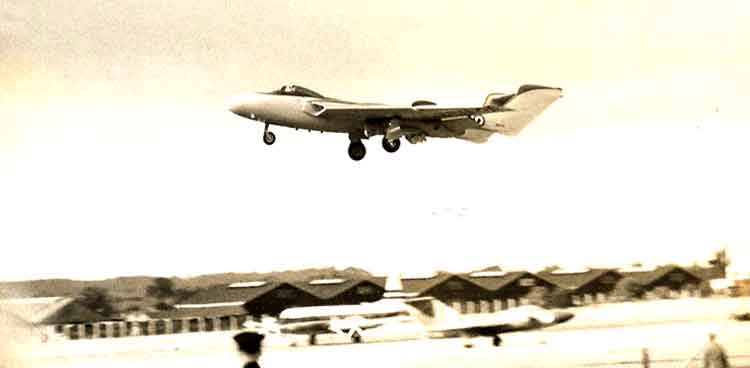
|
||
|
de Havilland DH.110 Sea Vixen coming in to land at the Farnborough Air Show - Sep53. At this time not known as the Sea Vixen. (Thanks to Mike Wraight.) de Havilland DH.110 Sea Vixen The de Havilland Sea Vixen originated in the DH.110 which had been incompetition with the Gloster Javelin for an RAF all-weather fighter requirement, but suffered a catastrophic breakup at the 1952 Farnborough air display. In 1956, the surviving DH.110 prototype underwent carrier trials, and the first fully navalized machine, with folding wings, flew on 20 March 1957. Known initially by the designation FAW.20 , the aircraft was later named Sea Vixen and re-designated FAW.Mk.1 In 1961, two FAW.Mk.1s received extra fuel tanks in forward extensions of the tail booms, and these served as the protoype FAW.Mk.2 which was issued to squadrons in 1965. Total Sea Vixen production was 126 Mk.1s and 30 Mk.2s with 67 Mk.1s being brought up to Mk.2 standard. SPECIFICATIONS: Crew: 2; Powerplant: two 5,094Kg (11,230lb) thrust Rolls-Royce Avon 208 turbojets; Performance: max speed: 1,110 km/h (690 mph); range: 965 Km (600 miles); service ceiling: 14,630 m (48,000 ft); Dimensions: wingspan: 15.54m (51ft); length: 17.02 m (55ft 7 in); height: 3.28 m (10ft 9in); Weight: 18,858 kg (41,575 lb) loaded; Armamemnt: four Firestreak or Red Top AAMs; Bullpup ASMs on underwing pylons. (Thanks to the Encyclopedia of Aircraft from Silverdale Books.) |
||